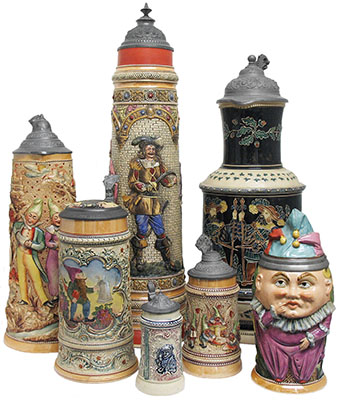
by Frank Loevi
This article is intended as an adjunct to the on-line Adolf Diesinger Stein Catalog in the Beer Stein Library. Clicking on any of the various links provided herein will produce a separate window displaying the catalog listing associated with the item cited in the text.
 |
More than two decades later, little new has been uncovered in the way of historical documentation of the company’s existence or products, and in that sense Diesinger remains among the more obscure of the major Westerwald manufacturers from the “Golden Age” of stein production of the late 19th and early 20th centuries. On the other hand, extensive progress has been made in identifying and cataloging Diesinger steins, with over 800 models currently pictured in the Beer Stein Library, including more than 300 examples of early threaded relief steins that barely rated a mention in the Manusovs’ Guide.
In this article, we’ll review some of the more important characteristics of Diesinger steins pointed out by the Manusovs, as well as explore new discoveries based mainly on observation of the now vastly expanded database of known examples, thereby providing readers with the ability not only to identify, but also to date Diesinger steins with considerably more confidence than has been possible in the past.
Stein Production Timeline
The Adolf Diesinger firm operated out of a factory opened in 1860 by Karl Diesinger (relationship unknown), taking over the facility sometime in the early 1890s. The exact transition date from Karl to Adolf Diesinger is unclear, and the earliest known record of Adolf Diesinger as the factory’s owner dates to 1893.1 However, there is presently no reason to believe that Karl Diesinger had any role at all in the production of steins recognized by today’s collectors as “Diesinger” products, even though the manufacture of some of those steins clearly predated 1893.
Early Production Period
Currently available evidence leads to the reasonably clear conclusion that steins manufactured by Adolf Diesinger can be divided into three distinct production periods. The first of these, referred to hereafter as the “early production period,” began circa 1890 and lasted until circa 1893. Counterintuitively, the mold numbers on known examples from this period begin with 1060 and run into the high 1400s, while mold numbers found on later pieces are confined to three digits or less.
The date range of this production period has been established based on engraved lid dates, with the earliest known example dated 1890 and the earliest known example from the next production period (discussed below) dated 1894. However, it should be understood that dated lids are quite rare, occurring on less than one of every 100 observed examples, making it easily possible that both the upper and lower parameters of the range may need to be adjusted as additional Diesinger steins with dated lids are discovered. Be that as it may, there is no remaining doubt regarding the fact that the earliest Adolf Diesinger steins had a different (and higher) numbering system than those that followed in later periods.
As might be expected, not all the steins produced by Diesinger during the early production period bore visible mold numbers. They did, however, have one overriding characteristic in common. Other than relief body bands found on some models, the decorating technique was, with rare exception, almost exclusively threaded relief. For some typical examples see Nos. 1130, 1267 and 1431. Of course, Diesinger was hardly the only stein manufacturer to decorate with threaded relief, but as collectors soon discover, there is a general sense of style associated with Diesinger threaded relief that is readily detectable and only rarely observable elsewhere.
Middle Production Period
Again based at least in part on lid dates, it would appear that currently identified Diesinger steins with mold numbers ranging from 2 through the low 200s (highest observed number is 220) were initially manufactured circa 1894 through 1900. It was during this period that the company began making the transition from threaded relief to relief, sometimes combining the two techniques in a manner unique to Diesinger (see, for instance No. 187, noting particularly the use of relief edelweiss in the designs), but more often than not producing relatively run-of-the-mill relief steins with commonly seen central decorations that can only be positively confirmed as Diesinger products based on factors such as a distinctive handle or a unique artist’s signature (for example Nos. 24 and 194).
A somewhat confusing note is introduced into the identification of middle production period steins by the fact that some steins with model numbers within the stated range have beaded backgrounds and may even bear the base mark “D.R.G.M. 154927” which, for reasons explained further on, could not have been produced until at least the year 1901. However, it is often the case that where this occurs the steins in question have been observed in multiple versions, some with D.R.G.M. 154927 characteristics and others without (see, for example Nos. 33 and 192, noting particularly the presence or absence of beaded backgrounds). When these observations are combined with lid date findings, the apparent anomaly is easily explained as being the result of multiple production runs, with some Diesinger steins that were first introduced in the middle production period being remade subsequent to 1901 in D.R.G.M. 154927 versions.
Late Production Period
The most readily identifiable Diesinger steins are those produced between 1901 and termination of the company’s operations circa 1910. The starting date of this period coincides with the issuance to Adolf Diesinger of D.R.G.M. 154927 by the German Patent and Trademark Office, which will be discussed in more detail in the next section. The circa 1910 termination date is based on somewhat suspect documentation in the Manusovs’ Guide2, and is used here simply because no more reliable reference exists, but it appears likely that production had actually ground to a halt a year or two earlier.
Mold numbers in the late production period run from 500 through the high 900s, with the highest observed number being 972. During this period almost all examples were produced in full relief with textured backgrounds, with a handful of exceptions limited principally to some character steins, plus a few items produced as operations were winding down and bearing mold numbers 940 and above.
All Diesinger character steins were manufactured during the late production period, as were all the steins bearing Diesinger’s second patent number, D.R.G.M. 250635, issued for a ceramic hinge attachment, both of which will be examined in detail further on. And finally during this period we see two of Diesinger’s rare “etched” offerings, numbered 971 and 972, neither of which is particularly noteworthy for any reason other than they represent the last two steins believed to have been produced in the Diesinger factory.
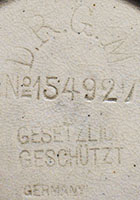 |
The most reliable identifying characteristic for late production period Diesinger steins can be found by simply turning them over. On the bottom of many (although far from all), �D.R.G.M.� base marks will be seen. D.R.G.M. is an acronym for Deutsches Riech Gebrauchsmuster (German Empire Registered Design) and comparable in most respects to �Patent Protected� in the United States.
D.R.G.M. 154927
D.R.G.M. 154927 was issued to Adolf Diesinger on 9 April 1901 and notification of the patent was applied to the bases of many Diesinger steins from that point forward. The notification can be found in two configurations. The earliest, shown in Figure 2, saw only limited early application before being replaced by the second notification style, shown in Figure 3. The existence of either one of these marks is an absolutely certain indicator that the stein in question is a product of the Diesinger factory.
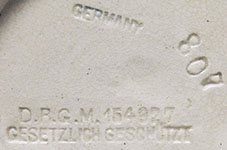 |
The original German summary statement describing the coverage of D.R.G.M. 154927 reads as follows:
“Vorrichtung zur genauen und scharfen Abgrenzung der Farben auf Porzellan, Steingut, Majolika u. dgl., bestehend aus einer gravierten Reliefkontur bei allen figürlichen und ornamemtatlan Darstellunge.”
For those who are fluent in German, the statement speaks for itself, but the majority of American collectors (i.e., possessing limited German vocabularies) have had to rely on the Manusov translation that reads…
“Machining to the exact and sharp demarcation of colors on porcelain, ceramic and majolica, etc., consisting of hand-worked relief of all figures and decorative representations.”3
…and that unfortunately leaves the nature of what is covered by the patent more than a little unclear, leading to considerable confusion over the years. A more accurate English rendering of the patent summary might read:
“Process for the exact and sharp demarcation of colors on porcelain, stoneware, majolica, etc., consisting of an engraved relief outline on all figural and ornamental presentations.” (Emphasis added)
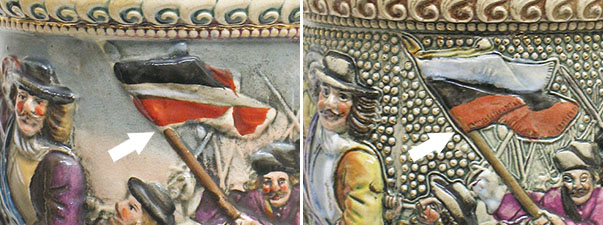 |
As noted earlier in our Stein Production Timeline, almost all steins manufactured by Diesinger from 1901 forward have relief images and textured backgrounds, more often than not in the form of closely spaced beading. Starting around 1905 examples can also be regularly seen where the beading is replaced by impressed texturing, referred to hereafter as “cratering”. In either case, the problem for Adolf Diesinger was how to cleanly separate the textures in the backgrounds from the relief images. His solution was an “engraved relief outline” around the exterior borders of relief images. Where the background was beaded, the engraved outline was further clarified with a line of threading at its outside edge.
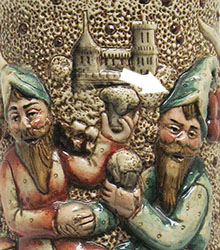 |
When Diesinger began producing steins with cratered backgrounds, as opposed to beading, it would appear that there was no longer a perceived need to enhance the engraved outline around relief figures with threading. However, models with cratered backgrounds still got the engraved outline and, consequently, still qualified for the “D.R.G.M. 154927” base mark. As can be seen in the detail from Diesinger No. 777 shown in Figure 5, the outlining around the relief images is far less distinctive than what we see in Figure 4, and there can be little doubt that the steins with cratered backgrounds were somewhat easier to produce without the added threading. Nonetheless, cratered backgrounds did not replace beaded backgrounds, and both styles can be seen from circa 1905 forward.
By now it should be evident that textured backgrounds are as much a part of the D.R.G.M. 154927 look as the patented “engraved relief outlines,” and in no instance will one be found on a Diesinger stein without the other. Unfortunately, while all steins decorated in that manner qualified by definition for the D.R.G.M. 154927 marking, application of the mark was far from consistent. That being the case, we’ll take a closer look at textured backgrounds as a separate (if secondary) Diesinger identifier in a another discussion a little further on.
D.R.G.M. 250635
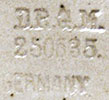 |
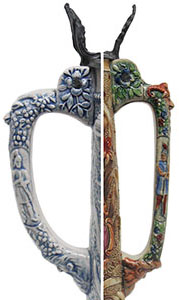 |
From the manufacturer’s standpoint, the system had two significant advantages: first, it required less pewter (an expensive commodity); and second, application of the lid was far less labor intensive than with the traditional mounting method.
Note that although the pictured handles have somewhat different overall shapes, the same relief imagery appears on both, as well as on the vast majority of steins which used this patented hinge attachment. One observed exception is Diesinger No. 706, which has so far not been seen on an example marked with the D.R.G.M. notification, and may well have been a precursor to the patent. The lowest observed model number to incorporate the patented hinge attachment into the “standard” handle shown in Figure 7 is No. 743, presumably first produced in 1905 when the patent was issued. The attachment was used often for about a year thereafter (through model No. 810), at which point the company apparently returned to the more traditional configuration. In reviewing the two cited examples, note that in both cases, as well as others, versions exist with traditional pewter lid attachments, almost certainly produced at some point subsequent to use of the ceramic hinge attachment being terminated.
So what happened? In all likelihood, the unusual D.R.G.M. 250635 mounting configuration resulted in more than the usual amount of breakage, and a broken ceramic hinge attachment is far more difficult to repair than the more standard pewter attachment. That being the case, the system would have been (and apparently was) quickly abandoned as the problems with it began to surface. However, the patented lid attachment did make a brief comeback a few years later during the period when Diesinger operations were drawing to a close, perhaps in a last ditch effort to save money and continue production (e.g., No. 964), but apparently to no avail.
Before moving on, it should be pointed out that the easily recognizable imagery seen in in Figure 7 can also be found on handles with more traditional lid attachments, providing yet another late production period Diesinger recognition tool for observant collectors, albeit one with only limited application. More about Diesinger handles later.
 |
It’s worth noting here that, while not often seen, at least one other D.R.G.M. notification (Figure 8) can be found on ceramic beer steins and its appearance has regularly resulted in collector misidentifications. In 1898, D.R.G.M. 94507 was issued to Mathias Girmscheid for a recessed base construction method. Although the limited number of steins on which notification of the Girmscheid patent has been seen have few characteristics in common with late production period Diesingers, D.R.G.M. marks on steins have over the years become so synonymous with Diesinger that many collectors have been guilty in the past of failing to pay attention to the details of the number.
Additional Marks
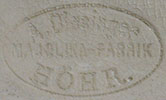 |
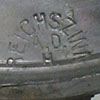 |
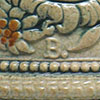 |
Of somewhat greater practical value is the “A.D./H.” pewter mark shown in Figure 10. Although also relatively rare, occurring less than 2% of the time, it can be found on examples from all three production periods. That being the case, in addition to serving as a certain Diesinger identifier, it also contributes strongly to the conclusion that Adolf Diesinger (as opposed to Karl) was responsible for the production of all beer steins recognized as Diesinger products by today’s collectors.
 |
Another mark that can be useful for identifying middle production period Diesinger is the stylized “LH” base mark shown in Figure 12. We know that “LH” was not an artist/modeler because the mark has been seen in conjunction with the “B.” artist’s signature discussed above, so it is presumed that the LH base mark was applied to indicate the completion of some phase of the production process. Whatever its purpose, the LH base mark as configured in Figure 12 is unique to Diesinger and a certain identifier.
 |
When using the LH base mark as a Diesinger identifier, it’s important to be aware of the fact that there was a Jugendstil artist by the name of Leonhard Hellmuth who in 1904 provided some forty designs to the firm of Reinhold Merkelbach and each of these items was produced with an LH base mark (Figure 13) that might easily be confused with the Diesinger LH. Note, however, that although the general configuration is similar, Helmuth’s initials are “sans serif” and thus readily distinguishable.
Textured Backgrounds
As we’ve already seen, textured backgrounds were part and parcel of the D.R.G.M. 154927 visual effect on late production period Diesinger steins, even though the patent itself covered only the “engraved relief outline” that separated the texturing from relief images. The reason this is important is that as many as a third of all Diesinger steins that qualified for the D.R.G.M. 154927 base mark did not get one, so collectors are left with the need, in many cases, to look beyond base marks to physical traits, and one of the most obvious signs of a Diesinger stein is a textured background.
|
|
Background texturing on Diesinger steins exists in two basic formats. The first of them, raised beading, as illustrated in Figure 14, can be found with small or medium beads (left), large beads (center), and often on full color examples with beads brushed with gold paint to highlight the effect (right).
The second type of background texturing is impressed “cratering” which is also found in varying patterns, as can be seen in Figure 15. This type of texturing is first observed on a character stein (Clown with Banjo, No. 721, circa 1905) and can be found both on character steins and on steins with more traditional configurations from that point forward.
Caution! — Although unusual from other makers, not all textured backgrounds were produced by Diesinger.
The problem to be faced with this type of identification is that not every beer stein with a textured background was necessarily manufactured in the Diesinger factory. Figure 16 illustrates some of the potential pitfalls to be faced with textured background identifications.
On the left is a detail from Hauber & Reuther stein No. 171, one of a number of similarly configured HR pieces that made use of beading to distinguish the background from the “tapestry” type central decoration. However, a close look reveals that the format of the beading is fairly linear and reasonably distinguishable from Diesinger beading on that basis alone, but note also the absence of an incised line and threaded border around the central decoration. It is currently believed that no manufacturer other than Diesinger used beaded backgrounds in combination with incised and threaded image borders, à la D.R.G.M. 154927, so identification issues stemming from beaded backgrounds will normally have a relative straightforward solution.
 |
The image on the right in Figure 16 is a detail from Marzi and Remy No. 1783, one of a group of M&R steins that made use of “cratered” background texturing as a decorative device. In this case, however, distinguishing the decoration from Diesinger steins with similar background texturing is not so easily accomplished, in that the stein also has a painted line around relief images that closely mimics the incised line on cratered Diesinger D.R.G.M. 154927 steins, making it necessary to literally feel for the incised line to confirm its absence.
Handles
A perhaps more reliable method for identifying Diesinger steins in the absence of a manufacturer’s mark can be found in many cases with the handles, and as identifiers they have the additional attraction of applicability across all three production periods.
 |
Diesinger, like most manufacturers, used many different handles, some only once or twice. The Manusovs’ Guide pictured twenty-two, but nearly three times that many have been observed over time. The seven shown in Figure 17 represent the most frequently seen, together accounting for around 75% of known Diesinger steins.
Handles 1 through 4 were also introduced in the early production period, but continued to be used throughout the life of the company. Handles 5 and 6 first appear on middle production period steins and, again, are used continuously thereafter. Handle No. 7 doesn’t make its first appearance until the late production period, but even so is one of the most frequently used overall.
Caution! — Details matter: similar handles were produced elsewhere.
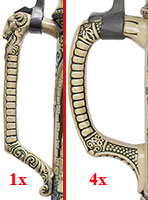 |
Compare, for instance, the handles labeled “1” and “1x” in Figures 17 and 18, noting particularly the ram’s head at the top of each. Handle No. 1 is one of the most frequently seen on Diesinger steins, and over the years the ram’s head ornamentation has become closely associated with Diesinger. Handle No. 1x can be found on multiple designs produced by J.L. Knoedgen of Ransbach (see “J.L. Knoedgen Revealed”). Given the nearly identical ram’s head, it takes no great insight to understand how it could easily form the basis for a Knoedgen stein being misidentified as Diesinger.
The handles labeled “4” and “4x” are likely to confuse even the most careful observer. Handle 4x, found frequently on D�mler & Breiden steins, differs from its Diesinger counterpart only in the most minor details. That being the case, Diesinger handle No. 4 has a somewhat diminished value as an identifier and is best used only to confirm an identification based on other characteristics.
Threaded Relief Lid Inlays
Threaded relief lid inlays are currently believed to be unique to Diesinger and therefore a highly reliable method for identifying both early and middle production period Diesinger steins. They are always found in conjunction with threaded relief body decoration and, consequently, do not exist as original equipment on late production period examples. Those pictured in Figure 19 show a significant portion of observed examples, but several others are also known to exist. As can be easily seen, with one exception they all exhibit a similar aesthetic “look and feel,” both in imagery and coloring, that is hard to miss.
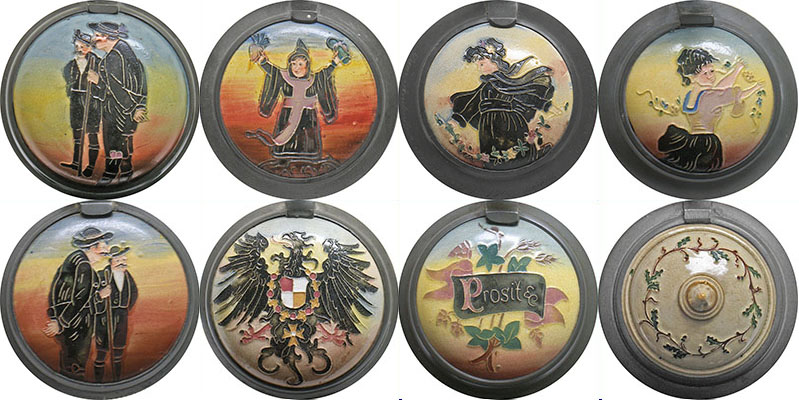 |
The imagery and coloring found on lid inlays can also be seen on some Diesinger stein bodies and can therefore contribute to the identification of Diesinger threaded relief steins regardless of lid type (see, for example, Nos. 1306 and T22).
The lid on the bottom right is unique in that it combines threaded relief with a spiked ceramic finial. This lid has so far been seen only on early production period examples with the same general coloring and often with complementary leafy vine decoration, as in No. T68.
Some Additional Visual Cues
(and Cautions)
Gnome Images
By far the most frequently occurring theme, particularly in late production period Diesinger steins, involves Gnomes (Elves, Dwarves, Heinzelmenschen) engaged in activities we’ve all come to regard as typical of those magical little people. Long-time collectors, having been frequently exposed to such depictions, are able to spot them on a Diesinger stein even at a distance or from a computer generated thumbnail image … at least most of the time.
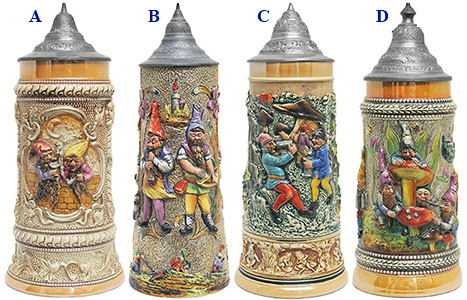 |
Sometimes even the most accomplished spotter may be less than certain. Figure 20 shows four relief steins depicting gnomes in typical poses. All four have textured backgrounds and similar imagery. Can you pick the one that wasn’t made by Diesinger?
If you guessed “C”, you’re either pretty lucky or someone who probably doesn’t need to be reading this article. Stein C can be distinguished as a product of Marzi & Remy by the bottom frieze, which is unique to hollow-based M&R steins. But even without that knowledge, it could have been determined that stein C was not a Diesinger by the fact that body bands serving as separators were plain, as opposed to beaded. Late production period Diesinger steins used beaded separator bands without exception, and hence we now have one more weapon in our arsenal of Diesinger recognition tools. That’s not to say, of course, that other manufacturers didn’t use beaded body bands, but where plain banding is used, it’s definitely not a late production period Diesinger stein. Unfortunately, that rule cannot be applied with equal assurance to early and middle production period Diesingers.
Landsknechte Images
Although scenes featuring gnomes provide the most frequently encountered imagery on late production period Diesinger steins, it’s Landsknechte that take the prize on the threaded relief pieces from Diesinger’s early and middle production periods. Depictions of these feudal “soldiers” account for nearly twenty percent of cataloged Diesinger output from circa 1890 to 1900. So with all that exposure, spotting them should be pretty easy for a veteran Diesinger collector, and for the most part it is, but not always.
Let’s try another little multiple choice quiz. Which of the four threaded relief Landsknecht depictions in Figure 21 is not on a Diesinger stein?
 |
This one may be a little more difficult in that all four have similar imagery and plain backgrounds, plus (although it may be hard to see in Figure 21) all of them also have beaded banding, so our key for finding the non-Diesinger stein in Figure 20 won’t work here.
If you guessed “B”, you are correct, but only because you’ve either seen that one before or you made a lucky stab in the dark, since there is no way based solely on the images presented that an informed choice could be made. In fact, stein B was thought by some very serious collectors to be a Diesinger product until it was spotted in an old Reinhold Hanke manufacturer’s catalog. Hanke No. 1009 is one of a number of similarly decorated Hanke steins, principally found in a group of serving sets with model numbers ranging from 1003 to 1009, that feature threaded relief images of Landsknechte and gnomes and are largely indistinguishable from a good number of similarly configured early production period Diesinger pieces.
Interestingly, a lid date of 1890 was found on an example of Hanke No. 1007, one of the steins in the 1003-1009 Hanke grouping. Given the fact that very similar styling is also found on Diesinger steins beginning in 1890 and continuing for several years thereafter, it’s not at all unreasonable to conjecture that the same artist supplied designs to both firms, perhaps even moving from Hanke to Diesinger after completing the Hanke serving sets.
On the positive side, other than the handful from Hanke, there are no known threaded relief steins that match up very closely with those produced by Diesinger, so once one is aware of that fairly limited number of Hanke look-alikes, their existence ceases to be a problem.
Overall, the point that needs to be gleaned, both from this section and some of the material above, is that Germany’s Kannenbäckerland in the 1890s was a relatively small and close knit community, where artists and styles often traveled freely between producers. So even where a design trait is believed to be “typical” of a particular manufacturer, it doesn’t necessarily follow that the trait is “unique” to that manufacturer. That being the case, it’s always advisable to look for multiple indicators, and also to check for catalog confirmation where it’s available.
Character (Figural) Steins
And finally, we get to Diesinger character steins, which in many ways form a unique subset of late production period Diesinger offerings. More than 60 Diesinger character steins have been identified to date, a small sampling of which is shown in Figure 22. Diesinger character steins all had mold numbers between 692, circa 1904 (Man with Hangover, far left) and 858, circa 1908 (Sitting Monkey, far right). All the steins shown in Figure 22 are half-liter, which is the predominant size, but capacities can range from ⅛-liter (e.g., No. 849) to 3-liters (e.g., No. 726).
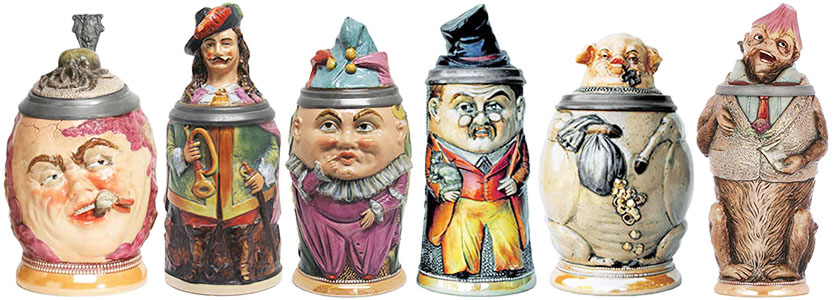 |
Like the Jester (No. 747) and the Man with Tomcat (No. 765) shown in the center of Figure 22, about a third of Diesinger character steins have textured background features with incised borders and are consequently qualified for the D.R.G.M 154927 base mark, although application of the mark is no more consistent than with more traditional body types, so the need for secondary identification characteristics will often come into play. The most reliable of those by far is a unique combination of mold number, stacked GESETZLICH/GESCH�ZT and small (i.e., approximately 10 pt.) sans serif “GERMANY” (Figure 22), both with and without an accompanying D.R.G.M 154927, but not necessarily in any particular order. All Diesinger figural steins are highly likely (but not certain) to be marked in that manner, as are many other late production period Diesinger steins.
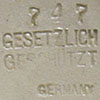 |
Where all else fails, another highly reliable recognition factor, although less universal than base markings or handles, derives from Diesinger’s use of beaded body bands around the bases of most character steins. Unfortunately, where there is only one band, the characteristic is shared with at least two other major Westerwald producers, but where there are two bands, as seen on the Man with Hangover and the Pig with Money Bag (No. 698) in Figure 22, the trait is unique to Diesinger and, again, a certain identifier.
To date, no Diesinger character stein has been encountered that didn’t display at least two of the characteristics discussed above, so as with most late production period Diesinger steins, identification should be a relatively straightforward process, even where no D.R.G.M. number is found.
A Closing Thought
Given the limited availability of historical documentation on Adolf Diesinger, his company and its output, and the equally limited likelihood of any significant documentary discoveries surfacing in the foreseeable future, what we’ll be able to add to our knowledge base prospectively will in all probability have to come from the steins themselves. As this article makes clear, significant progress has been made in that regard, but there’s still much to be learned. For instance, the discovery of additional Diesinger steins with dated lids will help to refine what we know about the timing and duration of Diesinger’s three production periods. And, of course, each new stein that gets added to the online Diesinger catalog, with or without a dated lid, takes us one more step toward achieving a “complete” inventory of the output from one of the Westerwald’s most important and innovative stein makers.
If you are able to contribute to this ongoing discovery process with photos, new facts or both, please take the time to send an email to [email protected]. Remember, information sharing by members is what makes the Beer Stein Library work for all of us.
__________
1Manusov, Patricia L. and Manusov, Eugene V.: A Collector�s Guide to Diesinger Steins; Bristol Press; 1991; at page 6.
2Ibid; at page 7.
3Ibid; at page 1.
4Adressbuch der keramischen Industrie; Müller & Schmidt; Coburg; 1906; at page 28.
__________
Heartfelt thanks to John Hataloski, whose untiring efforts combined with his incredible collection of more than 1,000 Diesinger beer steins provided the models for most of the examples either pictured or referenced in this article, as well as the majority of those shown in the Library’s online Diesinger Stein Catalog. Without his continuing support spanning a time period of nearly two decades, neither would have been possible.
__________
© 2011-2015 Beer Stein Library — All rights reserved.